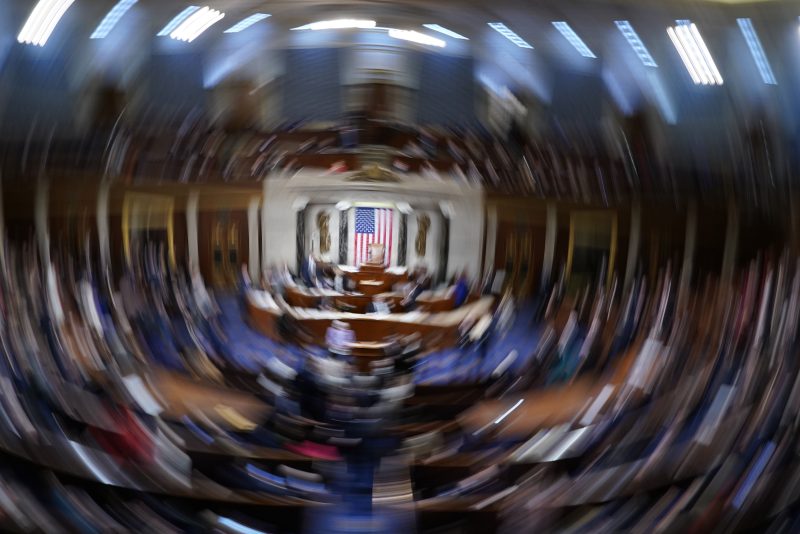Early on a Sunday morning in November, thousands of people will line up at the southern end of the Verrazzano-Narrows Bridge connecting Staten Island to Brooklyn to await the start of the New York City Marathon. The process of beginning the race is complex, involving the staggered starts of various levels of competitors. But, then, the race is underway.
The salient question Wednesday morning is this: What is the status of things before the competitors start running? There’s still a Marathon, as an event, certainly; the structure and organization required are in place. But there’s no marathon. There are “runners,” but no runners. It’s a chemical reaction awaiting its catalyst.
This, as it happens, was the state of the United States House of Representatives as dawn broke. The institution exists, as does the New York City Marathon just as the race gets underway. But one can argue that the House has no members, and it’s not clear that it can take any legislative action. It is almost entirely potential energy and very little kinetic.
The House is in a state that seems common in recent years: an existential limbo in which the old, loosely written rules have proved inadequate for describing reality.
It wasn’t until the ratification of the 20th Amendment in 1933 that Jan. 3 became the formal starting point for a new Congress.
“The Congress shall assemble at least once in every year,” that amendment states, “and such meeting shall begin at noon on the 3d day of January, unless they shall by law appoint a different day.”
At noon on Tuesday, the old, 117th Congress was done and the new, 118th Congress begun. But, of course, the instantiation of a “Congress” is different from a Congress being able to act. And the Constitution has other requirements that also must be met, as written in Article VI.
“The Senators and Representatives before mentioned, and the Members of the several State Legislatures, and all executive and judicial Officers, both of the United States and of the several States,” it reads, “shall be bound by Oath or Affirmation, to support this Constitution.”
A report from the endlessly useful Congressional Research Service explains the step-by-step chain of events that usually leads to the swearing-in of members of the House. First, the House convenes (at noon on Jan. 3, unless the prior Congress changes things). There’s no clerk of the House yet, so the clerk of the preceding Congress checks that there’s a quorum — meaning that at least half of the full body is present. Then, the chamber votes on a speaker, itself a role defined in the Constitution. The speaker is sworn in.
The speaker then swears in the members-elect. That happens en masse on the House floor, but photographs are banned; the photos you see of new members posing with the speaker are ceremonial, souvenirs.
You can see the problem. On Tuesday, after three votes, the House had failed to select a speaker. Without a speaker, there was no administration of the oath to the new members. So they wait at the starting line, “runners” instead of runners. Or, to use the proper vernacular, members-elect instead of members.
This is not entirely a nominal point. House procedures state that, in keeping with Article VI, unsworn members are not fully empowered as elected officials.
“Until a Member-elect has subscribed to the oath, he does not enjoy all the rights and prerogatives of a Member of Congress,” the formal guidelines read. “Members who have not taken the oath are not entitled to vote or to introduce bills. However, unsworn Members have participated at the beginning of a session in organizational business, such as the election of the Speaker.” You can be named to a committee before being sworn, it notes — but you can’t serve on it until the swearing-in occurs.
And, of course, because no bills can be introduced or voted on, no legislation can pass the House. And if no legislation can pass the House, no legislation can be sent from Congress to the White House to become law. No newly named post offices, no massive spending bills, nothing.
This is, of course, largely an academic exercise, as is thinking about the state of the New York City Marathon before it gets underway. It’s interesting only because of the duration of the pause, a longer gap between potential and kinetic than we’ve seen since 1923, the last time a vote for speaker went to multiple ballots.
But that’s the question that’s actually salient: What happens if the marathon never begins? If the competitors are just standing there on the bridge for hours as the organizers try to resolve a dispute over who gets to fire the starter’s pistol.
In that case, the answer is pretty obvious: Most competitors will just go home and demand a refund of their entry fees. In the case of the House, the answer is different; members-elect aren’t simply going to go out and find new jobs. There could, for example, be a temporary speaker, a speaker pro tempore, who is selected by acclamation to move things along. This has happened a number of times before. The House could also change the rules to allow the election of a speaker by a plurality of votes instead of a majority of the votes cast. This is how the speaker was chosen in 1856, after more than 100 rounds of voting.
Or the House could simply agree to a new speaker in one of the next few ballots, limiting the delay in the swearing-in of new members to a day or two. This is unquestionably the most likely outcome, given the general interest in resolving the impasse as quickly as possible. But it also means that we are assuming things will progress more or less as expected in the federal government, which is not always a safe bet.
Even the New York City Marathon is canceled unexpectedly sometimes.



























